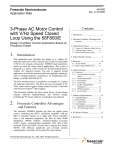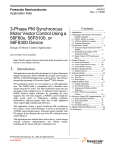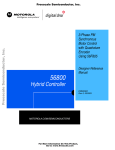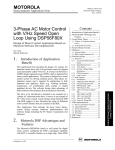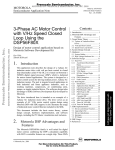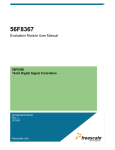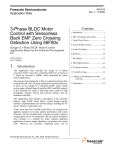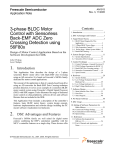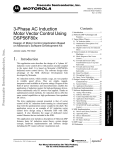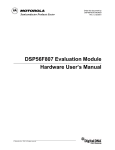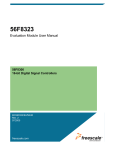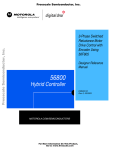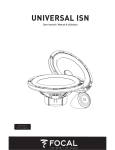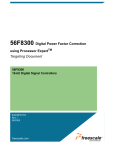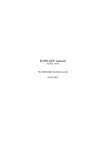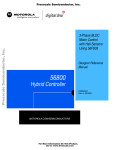Download DRM021, 3-Phase ACIM Volt per Hertz Using 56F80x Control
Transcript
Freescale Semiconductor, Inc... Freescale Semiconductor, Inc. 3-Phase ACIM Volt per Hertz Control Using 56F80x Designer Reference Manual 56800 Hybrid Controller DRM021/D Rev. 0, 03/2003 MOTOROLA.COM/SEMICONDUCTORS For More Information On This Product, Go to: www.freescale.com Freescale Semiconductor, Inc... Freescale Semiconductor, Inc. For More Information On This Product, Go to: www.freescale.com Freescale Semiconductor, Inc. Freescale Semiconductor, Inc... 3-Phase ACIM V/Hz Control Using 56F80x Designer Reference Manual — Rev 0 by: Jaroslav Musil Motorola Czech Systems Laboratories Roznov pod Radhostem, Czech Republic Original code by Petr Uhlir. DRM021 — Rev 0 Designer Reference Manual MOTOROLA 3 For More Information On This Product, Go to: www.freescale.com Freescale Semiconductor, Inc. Revision history To provide the most up-to-date information, the revision of our documents on the World Wide Web will be the most current. Your printed copy may be an earlier revision. To verify you have the latest information available, refer to: http://www.motorola.com/semiconductors Freescale Semiconductor, Inc... The following revision history table summarizes changes contained in this document. For your convenience, the page number designators have been linked to the appropriate location. Revision history Date Revision Level January 2003 1 Description Initial release Designer Reference Manual Page Number(s) N/A DRM021 — Rev 0 4 MOTOROLA For More Information On This Product, Go to: www.freescale.com Freescale Semiconductor, Inc. Designer Reference Manual — 3-Phase ACIM V/Hz Control List of Sections Section 1. Introduction . . . . . . . . . . . . . . . . . . . . . . . . . . . 13 Freescale Semiconductor, Inc... Section 2. Control Theory . . . . . . . . . . . . . . . . . . . . . . . . 17 Section 3. System Concept . . . . . . . . . . . . . . . . . . . . . . . 23 Section 4. Hardware . . . . . . . . . . . . . . . . . . . . . . . . . . . . . 27 Section 5. Software Design . . . . . . . . . . . . . . . . . . . . . . . 41 Section 6. Application Setup . . . . . . . . . . . . . . . . . . . . . . 57 Appendix A. References. . . . . . . . . . . . . . . . . . . . . . . . . . 71 Appendix B. Glossary. . . . . . . . . . . . . . . . . . . . . . . . . . . . 73 DRM021 — Rev 0 Designer Reference Manual MOTOROLA 5 For More Information On This Product, Go to: www.freescale.com Freescale Semiconductor, Inc. Freescale Semiconductor, Inc... List of Sections Designer Reference Manual DRM021 — Rev 0 6 MOTOROLA For More Information On This Product, Go to: www.freescale.com Freescale Semiconductor, Inc. Designer Reference Manual — 3-Phase ACIM V/Hz Control Table of Contents Freescale Semiconductor, Inc... Section 1. Introduction 1.1 Contents . . . . . . . . . . . . . . . . . . . . . . . . . . . . . . . . . . . . . . . . . .13 1.2 Introduction . . . . . . . . . . . . . . . . . . . . . . . . . . . . . . . . . . . . . . . . 13 1.3 Motorola DSP Advantages and Features . . . . . . . . . . . . . . . . . 13 Section 2. Control Theory 2.1 Contents . . . . . . . . . . . . . . . . . . . . . . . . . . . . . . . . . . . . . . . . . .17 2.2 Target Motor Theory . . . . . . . . . . . . . . . . . . . . . . . . . . . . . . . . . 17 2.3 Volt per Hertz Control . . . . . . . . . . . . . . . . . . . . . . . . . . . . . . . . 20 2.4 Speed Close Loop System . . . . . . . . . . . . . . . . . . . . . . . . . . . .21 Section 3. System Concept 3.1 System Design Concept . . . . . . . . . . . . . . . . . . . . . . . . . . . . . . 23 Section 4. Hardware 4.1 Contents . . . . . . . . . . . . . . . . . . . . . . . . . . . . . . . . . . . . . . . . . .27 4.2 Introduction . . . . . . . . . . . . . . . . . . . . . . . . . . . . . . . . . . . . . . . . 27 4.3 The High Voltage Hardware Set . . . . . . . . . . . . . . . . . . . . . . . . 27 4.4 DSP56F805EVM Control Board . . . . . . . . . . . . . . . . . . . . . . . . 29 4.5 3-Phase AC BLDC High Voltage Power Stage. . . . . . . . . . . . . 34 4.6 Optoisolation Board . . . . . . . . . . . . . . . . . . . . . . . . . . . . . . . . . 36 4.7 Motor-Brake Specifications. . . . . . . . . . . . . . . . . . . . . . . . . . . .37 DRM021 — Rev 0 Designer Reference Manual MOTOROLA 7 For More Information On This Product, Go to: www.freescale.com Freescale Semiconductor, Inc. Table of Contents Section 5. Software Design 5.1 Contents . . . . . . . . . . . . . . . . . . . . . . . . . . . . . . . . . . . . . . . . . .41 5.2 Data Flow . . . . . . . . . . . . . . . . . . . . . . . . . . . . . . . . . . . . . . . . . 41 5.3 State Diagram. . . . . . . . . . . . . . . . . . . . . . . . . . . . . . . . . . . . . . 50 Freescale Semiconductor, Inc... Section 6. Application Setup 6.1 Contents . . . . . . . . . . . . . . . . . . . . . . . . . . . . . . . . . . . . . . . . . .57 6.2 Application Description . . . . . . . . . . . . . . . . . . . . . . . . . . . . . . . 57 6.3 Application Setup . . . . . . . . . . . . . . . . . . . . . . . . . . . . . . . . . . . 63 6.4 Project Files . . . . . . . . . . . . . . . . . . . . . . . . . . . . . . . . . . . . . . . 66 6.5 Application Build & Execute . . . . . . . . . . . . . . . . . . . . . . . . . . . 68 Appendix A. References Appendix B. Glossary Designer Reference Manual DRM021 — Rev 0 8 MOTOROLA For More Information On This Product, Go to: www.freescale.com Freescale Semiconductor, Inc. Designer Reference Manual — 3-Phase ACIM V/Hz Control List of Figures Figure Freescale Semiconductor, Inc... 2-1 2-2 2-3 2-4 2-5 3-1 4-1 4-2 4-3 4-4 4-5 5-1 5-2 5-3 5-4 5-5 5-6 5-7 5-8 6-1 6-2 6-3 6-4 6-5 6-6 6-7 Title Page Torque-Speed Characteristic at Const. Voltage & Frequency . 18 3- Phase Inverter . . . . . . . . . . . . . . . . . . . . . . . . . . . . . . . . . . . 19 Pulse Width Modulation . . . . . . . . . . . . . . . . . . . . . . . . . . . . . . 20 Volts per Hertz Control Method . . . . . . . . . . . . . . . . . . . . . . . .21 Closed Loop Control System . . . . . . . . . . . . . . . . . . . . . . . . . . 22 System Concept . . . . . . . . . . . . . . . . . . . . . . . . . . . . . . . . . . . . 25 High Voltage HW System Configuration. . . . . . . . . . . . . . . . . . 28 Block Diagram of the DSP56F805EVM . . . . . . . . . . . . . . . . . . 30 DSP56F805EVM Jumper Reference . . . . . . . . . . . . . . . . . . . . 31 Connecting the DSP56F805EVM Cables . . . . . . . . . . . . . . . . . 32 3-Phase AC High Voltage Power Stage . . . . . . . . . . . . . . . . . . 35 Data Flow . . . . . . . . . . . . . . . . . . . . . . . . . . . . . . . . . . . . . . . . . 42 Volt per Hertz Ramp . . . . . . . . . . . . . . . . . . . . . . . . . . . . . . . . . 44 3-ph Waveforms with DC-Bus Voltage Ripple Elimination . . . . 46 Sinewave generation . . . . . . . . . . . . . . . . . . . . . . . . . . . . . . . . 47 3-ph Sine Waves with 3rd Harm. Injection, Amp. = 100% . . . . 48 3-ph Sine Waves with 3rd Harm. Injection, Amp. = 50% . . . . . 49 State Diagram - General Overview. . . . . . . . . . . . . . . . . . . . . . 52 State - Application State Machine. . . . . . . . . . . . . . . . . . . . . . . 53 RUN/STOP Switch and UP/DOWN Buttons . . . . . . . . . . . . . . . 59 USER and PWM LEDs at DSP56F805EVM. . . . . . . . . . . . . . . 60 PC Master Software Control Window . . . . . . . . . . . . . . . . . . . . 62 Set-up of the 3-Phase ACIM V/Hz Control Application. . . . . . . 64 DSP56F805EVM Jumper Reference . . . . . . . . . . . . . . . . . . . . 65 Target Build Selection. . . . . . . . . . . . . . . . . . . . . . . . . . . . . . . . 68 Execute Make Command . . . . . . . . . . . . . . . . . . . . . . . . . . . . . 69 DRM021 — Rev 0 Designer Reference Manual MOTOROLA 9 For More Information On This Product, Go to: www.freescale.com Freescale Semiconductor, Inc. Freescale Semiconductor, Inc... List of Figures Designer Reference Manual DRM021 — Rev 0 10 MOTOROLA For More Information On This Product, Go to: www.freescale.com Freescale Semiconductor, Inc. Designer Reference Manual — 3-Phase ACIM V/Hz Control List of Tables Table Freescale Semiconductor, Inc... 3-1 4-1 4-2 4-3 4-4 6-1 6-2 6-3 Title Page Motor / Drive Specifications . . . . . . . . . . . . . . . . . . . . . . . . . . . 23 DSP56F805EVM Default Jumper Options . . . . . . . . . . . . . . . . 31 Electrical Characteristics of Power Stage. . . . . . . . . . . . . . . . . 36 Electrical Characteristics . . . . . . . . . . . . . . . . . . . . . . . . . . . . . 37 Motor - Brake Specifications. . . . . . . . . . . . . . . . . . . . . . . . . . . 39 Motor--Brake Specifications . . . . . . . . . . . . . . . . . . . . . . . . . . . 58 Motor Application States. . . . . . . . . . . . . . . . . . . . . . . . . . . . . . 60 DSP56F805EVM Jumper Settings . . . . . . . . . . . . . . . . . . . . . . 65 DRM021 — Rev 0 Designer Reference Manual MOTOROLA 11 For More Information On This Product, Go to: www.freescale.com Freescale Semiconductor, Inc. Freescale Semiconductor, Inc... List of Tables Designer Reference Manual DRM021 — Rev 0 12 MOTOROLA For More Information On This Product, Go to: www.freescale.com Freescale Semiconductor, Inc. Designer Reference Manual — 3-Phase ACIM V/Hz Control Section 1. Introduction Freescale Semiconductor, Inc... 1.1 Contents 1.2 Introduction . . . . . . . . . . . . . . . . . . . . . . . . . . . . . . . . . . . . . . . . 13 1.3 Motorola DSP Advantages and Features . . . . . . . . . . . . . . . . . 13 1.2 Introduction This section describes the design of a 3-phase AC induction motor drive with volt per hertz control in closed loop (hereinafter called V/Hz OL). It is based on Motorola’s 56F80x digital signal processor (DSP), which is dedicated for motor control applications. The system is designed as a motor control system for driving medium power, 3-phase AC induction motors. The part is targeted toward applications in both industrial and home appliance industries, such as washing machines, compressors, air conditioning units, pumps, or simple industrial drives. The software design takes advantage of Quick_Start developed by Motorola. The drive introduced here is intended as an example of a 3-phase AC induction motor drive. The drive serves as an example of AC V/Hz motor control system design using Motorola DSP. This document includes the basic motor theory, system design concept, hardware implementation, and software design, including the PC Master visualization tool inclusion. 1.3 Motorola DSP Advantages and Features The Motorola DSP56F805 is well suited for digital motor control, combining the DSP’s calculation capability with MCUs controller features on a single chip. This DSP offers a rich dedicated peripherals DRM021 — Rev 0 MOTOROLA Designer Reference Manual Introduction For More Information On This Product, Go to: www.freescale.com 13 Freescale Semiconductor, Inc. Introduction set, such as pulse width modulation (PWM) modules, analog-to-digital converter (ADC), timers, communication peripherals (SCI, SPI, CAN), on-board flash and RAM. Freescale Semiconductor, Inc... The DSP56F805, provides the following peripheral blocks: • Two pulse width modulator modules (PWMA & PWMB), each with six PWM outputs, three current status inputs, and four fault inputs, fault tolerant design with deadtime insertion, supports both centerand edge- aligned modes • Two 12-bit, analog-to-digital convertors (ADCs), supporting two simultaneous conversions with dual 4-pin multiplexed inputs, ADC and can be synchronized by PWM modules synchronized • Two quadrature decoders (Quad Dec0 & Quad Dec1), each with four inputs, or two additional quad timers A & B • Two dedicated general purpose quad timers totalling 6 pins: Timer C with 2 pins and Timer D with 4 pins • CAN 2.0 A/B module with 2-pin ports used to transmit and receive • Two serial communication interfaces (SCI0 & SCI1), each with two pins, or four additional MPIO lines • Serial peripheral interface (SPI), with configurable 4-pin port, or four additional MPIO lines • Computer operating properly (COP) timer • Two dedicated external interrupt pins • Fourteen dedicated multiple purpose I/O (MPIO) pins and 18 multiplexed MPIO pins • External reset pin for hardware reset • JTAG/on-chip emulation (OnCE™) • Software-programmable, phase lock loop-based frequency synthesizer for the DSP core clock • Memory configuration – 32252 × 16-bit words of program flash – 512 × 16-bit words of program RAM Designer Reference Manual 14 DRM021 — Rev 0 Introduction For More Information On This Product, Go to: www.freescale.com MOTOROLA Freescale Semiconductor, Inc. Introduction Motorola DSP Advantages and Features – 2K × 16-bit words of data RAM – 4K × 16-bit words of data flash – 2K × 16-bit words of boot flash The pulse-width-modulation (PWM) block offers high freedom in its configuration enabling to control the AC induction motor in efficient way. Freescale Semiconductor, Inc... The PWM block has the following features: • Three complementary PWM signal pairs, or six independent PWM signals • Features of complementary channel operation • Deadtime insertion • Separate top and bottom pulse width correction via current status inputs or software • Separate top and bottom polarity control • Edge-aligned or center-aligned PWM reference signals • 15-bits of resolution • Half-cycle reload capability • Integral reload rates from one to 16 • Individual software-controlled PWM output • Programmable fault protection • Polarity control • 20-mA current sink capability on PWM pins • Write-protectable registers The PWM outputs are configured in the complementary mode in this application. DRM021 — Rev 0 MOTOROLA Designer Reference Manual Introduction For More Information On This Product, Go to: www.freescale.com 15 Freescale Semiconductor, Inc. Freescale Semiconductor, Inc... Introduction Designer Reference Manual 16 DRM021 — Rev 0 Introduction For More Information On This Product, Go to: www.freescale.com MOTOROLA Freescale Semiconductor, Inc. Designer Reference Manual — 3-Phase ACIM V/Hz Control Section 2. Control Theory Freescale Semiconductor, Inc... 2.1 Contents 2.2 Target Motor Theory . . . . . . . . . . . . . . . . . . . . . . . . . . . . . . . . . 17 2.3 Volt per Hertz Control . . . . . . . . . . . . . . . . . . . . . . . . . . . . . . . . 20 2.4 Speed Close Loop System . . . . . . . . . . . . . . . . . . . . . . . . . . . .21 2.2 Target Motor Theory The AC induction motor is a workhorse of an adjustable speed drive systems. The most popular type is the 3-phase, squirrel-cage AC induction motor. It is maintenance-free, lower noise and efficient motor. The stator is supplied by a balanced 3-phase AC power source. The synchronous speed ns of the motor is given by 120 × f s n s = ------------------p [ rpm ] (2-1) where fs is the synchronous stator frequency in Hz, and p is the number of stator poles. The load torque is produced by slip frequency. The motor speed is characterized by a slip sr: n sl ( ns – nr ) s r = -------------------- = -----ns ns [-] (2-2) where nr is the rotor mechanical speed and nsl is the slip speed, both in rpm. Figure 2-1 illustrates the torque characteristics and corresponding slip. As it can be seen from Equation 2-1 and Equation 2-2 the motor speed is controlled by variation of a stator frequency with influence of the load torque. DRM021 — Rev 0 MOTOROLA Designer Reference Manual Control Theory For More Information On This Product, Go to: www.freescale.com 17 Freescale Semiconductor, Inc. Torque Control Theory Motor Torque Load Torque 1 Working Point 0.5 0 n 0 Freescale Semiconductor, Inc... s r r 0 n Slip s Motor Speed Generator Figure 2-1. Torque-Speed Characteristic at Const. Voltage & Frequency In adjustable speed applications the AC motors are powered by inverters. The inverter converts DC power to AC power at required frequency and amplitude. The typical 3-phase inverter is illustrated in Figure 2-2. Designer Reference Manual 18 DRM021 — Rev 0 Control Theory For More Information On This Product, Go to: www.freescale.com MOTOROLA Freescale Semiconductor, Inc. Control Theory Target Motor Theory + DC-Bus C T 1 T 3 T 5 T 2 T 4 T 6 + - DC-Bus Freescale Semiconductor, Inc... Ph. B Ph. A Ph. C 3-Phase AC Motor Figure 2-2. 3- Phase Inverter The inverter consists of three half-bridge units where the upper and lower switch is controlled complementarily - meaning when the upper one is turned-on, the lower one must be turned-off and vice versa. As the power device’s turn-off time is longer than its turn-on time, some dead-time must be inserted between the turn-off of one transistor of the half-bridge and turn-on of it's complementary device. The output voltage is mostly created by a pulse width modulation (PWM) technique where an isosceles triangle carrier wave is compared with a fundamental-frequency sine modulating wave, and the natural points of intersection determine the switching points of the power devices of a half bridge inverter. This technique is shown in Figure 2-3. The 3-phase voltage waves are shifted 120o to each other and thus a 3-phase motor can be supplied. DRM021 — Rev 0 MOTOROLA Designer Reference Manual Control Theory For More Information On This Product, Go to: www.freescale.com 19 Freescale Semiconductor, Inc. Control Theory Generated Sine Wave PWM Carrier Wave 1 0 Freescale Semiconductor, Inc... ωt -1 1 PWM Output T 1 (Upper Switch) PWM Output T 2 (Lower Switch) 0 ωt 1 0 ωt Figure 2-3. Pulse Width Modulation The most popular power devices for motor control applications are Power MOSFETs and IGBTs. A Power MOSFET is a voltage controlled transistor. It is designed for high frequency operation and it has a low voltage drop, thus it has low power losses. However, the saturation temperature sensitivity limits the MOSFET application in high power applications. An insulated gate bipolar transistor (IGBT) is a bipolar transistor controlled by a MOSFET on its base. The IGBT requires low drive current, has fast switching time, and is suitable for high switching frequencies. The disadvantage is its higher voltage drop of the bipolar transistor, causing higher conduction losses. 2.3 Volt per Hertz Control Volt per Hertz control methods is the most popular method of Scalar Control, controls the magnitude of the variable like frequency, voltage or Designer Reference Manual 20 DRM021 — Rev 0 Control Theory For More Information On This Product, Go to: www.freescale.com MOTOROLA Freescale Semiconductor, Inc. Control Theory Speed Close Loop System current. The command and feedback signals are DC quantities, and are proportional to the respective variables. Freescale Semiconductor, Inc... The purpose of the volt per hertz control scheme is to maintain the air-gap flux of AC Induction motor in constant in order to achieve higher run-time efficiency. In steady state operation the machine air-gap flux is approximately related to the ratio Vs/fs, where Vs is the amplitude of motor phase voltage and fs is the synchronous electrical frequency applied to the motor. The control system is illustrated in Figure 2-4. The characteristic is defined by the base point of the motor. Below the base point the motor operates at optimum excitation because of the constant Vs/fs ratio. Above this point the motor operates under-excited because of the DC-Bus voltage limit. A simple close-loop volts/hertz speed control for an induction motor is the control technique targeted for low performance drives. This basic scheme is unsatisfactory for more demanding applications where speed precision is required. Volt per Hertz Characteristic Motor Base Point Voltage 100% Amplitude Base Frequency Frequency Frequency Frequency Figure 2-4. Volts per Hertz Control Method 2.4 Speed Close Loop System To improve the system performance, a closed-loop volts per hertz control was introduced. In this method a speed sensor measures the actual motor speed and the system takes this input into consideration. A DRM021 — Rev 0 MOTOROLA Designer Reference Manual Control Theory For More Information On This Product, Go to: www.freescale.com 21 Freescale Semiconductor, Inc. Control Theory number of applications use the closed-loop volts per hertz method because of its simple and relatively good speed accuracy, but it is not suitable for systems requiring servo performance or excellent response to highly dynamic torque/speed variations. Figure 2-5 illustrates the general principle of the speed PI control loop. Freescale Semiconductor, Inc... Reference Speed (Omega_required) Speed Error PI Controller Corrected Speed (Omega_command) Controlled System Actual Motor Speed (Omega_actual) Figure 2-5. Closed Loop Control System The speed closed loop control is characterized by the measurement of the actual motor speed. This information is compared with the reference speed while the error signal is generated. The magnitude and polarity of the error signal correspond to the difference between the actual and required speed. Based on the speed error the PI controller generates the corrected motor stator frequency in order to compensate for the error. In a case of AC V/Hz closed loop application, the feedback speed signal is derived from incremental encoder using the quadrature decoder. The speed controller constants have been tuned experimentally according to the actual load. Designer Reference Manual 22 DRM021 — Rev 0 Control Theory For More Information On This Product, Go to: www.freescale.com MOTOROLA Freescale Semiconductor, Inc. Designer Reference Manual — 3-Phase ACIM V/Hz Control Section 3. System Concept 3.1 System Design Concept Freescale Semiconductor, Inc... The system is designed to drive a 3-phase AC induction motor. The application meets the following performance specifications: • Targeted for DSP56F80XEVM platforms • Running on 3-phase ACIM motor control development platform at variable line voltage 115 - 230V AC • Control technique incorporates – motoring and generating mode – bi-directional rotation – V/Hz speed close loop • Manual Interface (Start/Stop switch, Up/Down push button speed control, LED indication) • PC Master Interface (motor start/stop, speed set-up) • Power stage identification • Overvoltage, undervoltage, overcurrent, and overheating fault protection The introduced AC drive is designed as a DSP system that meets the following general performance requirements: Table 3-1. Motor / Drive Specifications Motor Type Motor Characteristics: 4 poles, three phase, star connected, squirrel cage AC motor (standard industrial motor) Speed Range: Base Electrical Frequency: 50 Hz Max. Electrical Power: 180 W Delta Voltage (rms): DRM021 — Rev 0 MOTOROLA < 5000 rpm 200V (Star) Designer Reference Manual System Concept For More Information On This Product, Go to: www.freescale.com 23 Freescale Semiconductor, Inc. System Concept Drive Characteristics: Transducers: IRC -1024 pulses per rev. Speed Range <2250 rpm @ 230 V <1200 rpm @ 115 V Line Input: Max. DC Bus Voltage Control Algorithm Optoisolation Freescale Semiconductor, Inc... Load Characteristic: Type 230V / 50Hz AC 115V / 60Hz AC 400 V Close Loop Control Required Varying The DSP runs the main control algorithm. According to the user interface input and feedback signals, it generates 3-phase PWM output signals for the motor inverter. A standard system concept is chosen for the drive, and illustrated in Figure 3-1. The system incorporates the following hardware boards: • Power supply rectifier • 3-phase inverter • Feedback sensors: speed, DC-bus voltage, DC-bus current, temperature • Optoisolation • Evaluation board DSP56F805 Designer Reference Manual 24 DRM021 — Rev 0 System Concept For More Information On This Product, Go to: www.freescale.com MOTOROLA Freescale Semiconductor, Inc. System Concept System Design Concept Rectifier ~ Line Voltage 230V/50Hz Freescale Semiconductor, Inc... Three-Phase Inverter DC-Bus 3-ph AC M = Isolation Barrier Optoisolation Optoisolation Over Current & Over Voltage Temperature & DC-Bus Voltage Temperature & Voltage Processing IRC Temperature, Current & Voltage Sensing PWM Faults Processing ADC DC Bus Voltage V/Hz V1 DC-Bus V2 Ripple Cancel. PI Regulator Speed Set-up PWM Generator with Dead Time F E Speed Command Processing + - Actual Speed Speed Processing (Incremental Decoder) DSP56F80x Figure 3-1. System Concept The Control Process: When the start command is accepted, using the Start/Stop switch, the state of the inputs is periodically scanned. According to the state of the DRM021 — Rev 0 MOTOROLA Designer Reference Manual System Concept For More Information On This Product, Go to: www.freescale.com 25 Freescale Semiconductor, Inc. System Concept control signals (Start/Stop switch, speed up/down buttons or PC Master set speed) the speed command is calculated using an acceleration/deceleration ramp. Freescale Semiconductor, Inc... The comparison between the actual speed command and the measured speed generates a speed error E. The speed error is brought to the speed PI controller that generates a new corrected motor stator frequency. With the use of the V/Hz ramp the corresponding voltage is calculated and then DC-bus ripple cancellation function eliminates the influence of the DC-bus voltage ripples to the generated phase voltage amplitude. The PWM generation process calculates a 3-phase voltage system at the required amplitude and frequency, includes dead time. Finally the 3-phase PWM motor control signals are generated. The DC-bus voltage and power stage temperature are measured during the control process. They are overvoltage, undervoltage, and overheating protection of the drive. Both undervoltage protection and overheating are performed by ADC and software while the DC-bus overcurrent and overvoltage fault signals are connected to PWM fault inputs. If any of the above mentioned faults occurs, the motor control PWM outputs are disabled in order to protect the drive and the fault state of the system is displayed in PC Master control page. Designer Reference Manual 26 DRM021 — Rev 0 System Concept For More Information On This Product, Go to: www.freescale.com MOTOROLA Freescale Semiconductor, Inc. Designer Reference Manual — 3-Phase ACIM V/Hz Control Section 4. Hardware Freescale Semiconductor, Inc... 4.1 Contents 4.2 Introduction . . . . . . . . . . . . . . . . . . . . . . . . . . . . . . . . . . . . . . . . 27 4.3 The High Voltage Hardware Set . . . . . . . . . . . . . . . . . . . . . . . . 27 4.4 DSP56F805EVM Control Board . . . . . . . . . . . . . . . . . . . . . . . . 29 4.6 Optoisolation Board . . . . . . . . . . . . . . . . . . . . . . . . . . . . . . . . . 36 4.7 Motor-Brake Specifications. . . . . . . . . . . . . . . . . . . . . . . . . . . .37 4.2 Introduction The motor control system is designed to drive the 3-phase AC motor in a speed close loop. The designed software is capable to run only on high voltage HW set described below. Other power module boardswill be denied due to board identification build in SW. This feature protects misuse of the HW module. 4.3 The High Voltage Hardware Set The system configuration is shown in Figure 4-1. DRM021 — Rev 0 MOTOROLA Designer Reference Manual Hardware For More Information On This Product, Go to: www.freescale.com 27 Freescale Semiconductor, Inc. Hardware +12VDC 40w flat ribbon cable, gray U3 L Black N Light Blue PE Green-Yellow J11.1 J11.2 3ph AC/BLDC High Voltage Power Stage J14 GND 40w flat ribbon cable, gray U2 J1 U1 JP1.1 JP1.2 Optoisolation Board Controller Board J2 J1 ECOPT MB1 Black White Red J13.1 J13.2 J13.3 Motor-Brake AM40V 6 pin conn. AMP A2510 ECOPTHIVACBLDC Encoder Conn. Table SG40N Controler DSP56F803 DSP56F805 DSP56F807 Freescale Semiconductor, Inc... Incremental Encoder Baumer Electric BHK16.05A 1024-I2-5 Red White Black J5 Hall Sensor Encoder 00126A Conn. J2 J23 J4 ECMTRHIVAC Not used in application Incremental Encoder Cable -> Connector Table Cable Wire Color Desc. Brown White, Shielding Green Yellow Pink Unused +5VDC Ground and Shielding Phase A Phase B Index Unused Figure 4-1. High Voltage HW System Configuration All the system parts are supplied and documented according to the following references: • U1 - Controller board for DSP56F805: – supplied as: DSP56805EVM – described in: DSP56F805EVMUM/D DSP Evaluation Module Hardware User’s Manual • U2 - 3-ph AC/BLDC high voltage power stage – supplied in kit with optoisolation board as: ECOPTHIVACBLDC – described in: MEMC3BLDCPSUM/D - 3 Phase Brushless DC High Voltage Power Stage • U3 - Optoisolation board – supplied with 3-ph AC/BLDC high voltage power stage as: ECOPTHIVACBLDC Designer Reference Manual 28 DRM021 — Rev 0 Hardware For More Information On This Product, Go to: www.freescale.com MOTOROLA Freescale Semiconductor, Inc. Hardware DSP56F805EVM Control Board – or supplied alone as: ECOPT - optoisolation board – described in: MEMCOBUM/D Optoisolation board User’s Manual • MB1 motor-brake AM40V + SG40N Freescale Semiconductor, Inc... – supplied as: ECMTRHIVAC WARNING: It is strongly recommended to use an opto-isolation (optocouplers and optoisolation amplifiers) during the development time to avoid any damage to the development equipment. NOTE: The detailed description of individual boards can be found in comprehensive users’ manuals belonging to each board. The user manual incorporates the schematic of the board, description of individual function blocks and bill of materials. Individual boards can be ordered from Motorola as a standard product from http://mot-sps.com/motor/devtools/index.html. This section describes the design of the software blocks of the drive. The software will be described in terms of data flow and state diagrams. 4.4 DSP56F805EVM Control Board The DSP56F805EVM facilitates the evaluation of various features present in the DSP56F805 part. The DSP56F805EVM can be used to develop real-time software and hardware products based on the DSP56F805. The DSP56F805EVM provides the features necessary for a user to write and debug software, demonstrate the functionality of that software and interface with the customer's application-specific device(s). The DSP56F805EVM is flexible enough to allow a user to fully exploit the DSP56F805's features to optimize the performance of their product, as shown in Figure 4-2. DRM021 — Rev 0 MOTOROLA Designer Reference Manual Hardware For More Information On This Product, Go to: www.freescale.com 29 Freescale Semiconductor, Inc. Hardware DSP56F805 RESET LOGIC RESET Freescale Semiconductor, Inc... MODE/IRQ LOGIC MODE/IRQ Program Memory 64Kx16-bit Address, Data & Control SPI SCI #0 RS-232 Interface SCI #1 Peripheral Expansion Connector(s) TIMER Debug LEDs PWM LEDs Over V Sense GPIO Over I Sense Memory Expansion Connector(s) Zero Crossing Detect JTAG Connector DSub 25-Pin DSub 9-Pin CAN Interface CAN Data Memory 64Kx16-bit 4-Channel 10-bit D/A JTAG/OnCE PWM #1 A/D Parallel JTAG Interface PWM #2 Low Freq Crystal XTAL/EXTAL 3.3 V & GND Primary UNI-3 Secondary UNI-3 Power Supply 3.3V, 5.0V & 3.3VA Figure 4-2. Block Diagram of the DSP56F805EVM 4.4.1 DSP56F805EVM Configuration Jumpers Eighteen jumper groups, (JG1-JG18), shown in Figure 4-3, are used to configure various features on the DSP56F805EVM board. Table 4-1 describes the default jumper group settings. Designer Reference Manual 30 DRM021 — Rev 0 Hardware For More Information On This Product, Go to: www.freescale.com MOTOROLA Freescale Semiconductor, Inc. Hardware DSP56F805EVM Control Board JG6 1 9 6 3 3 JG10 3 2 1 JG13 8 USER 7 4 1 JG14 9 6 3 JG10 PWM JG15 J2 Y1 J23 JG17 JG6 1 3 2 1 JG13 JG12 JTAG DSP56F805EVM 1 JG15 JG1 JG2 1 1 JG16 1 1 JG18 Freescale Semiconductor, Inc... JG16 U1 JG3 J29 JG8 JG8 1 S/N U15 S4 S5 S6 GP1 S1 GP2 S2 RUN/STOP S3 P3 IRQA IRQB RESET J31 JG7 1 JG9 1 1 3 J24 3 2 1 3 JG2 1 2 JG4 JG1 7 JG4 1 3 3 7 2 4 1 1 JG14 JG12 LED3 JG11 P1 U9 JG5 JG5 U10 P1 3 JG9 1 JG3 3 2 JG18 7 JG17 1 JG7 JG11 8 Figure 4-3. DSP56F805EVM Jumper Reference Table 4-1. DSP56F805EVM Default Jumper Options Jumper Group Comment Jumpers Connections JG1 PD0 input selected as a high 1–2 JG2 PD1 input selected as a high 1–2 JG3 Primary UNI-3 serial selected 1–2, 3–4, 5–6 & 7–8 JG4 Secondary UNI-3 serial selected 1–2, 3–4, 5–6 & 7–8 JG5 Enable on-board Parallel JTAG Host Target Interface NC JG6 Use on-board crystal for DSP oscillator input 2–3 JG7 Selects DSP’s Mode 0 operation upon exit from reset 1-2 JG8 Enable on-board SRAM 1–2 JG9 Enable RS-232 output 1–2 JG10 Secondary UNI-3 Analog Temperature Input unused 1–2 JG11 Use Host power for Host Target Interface 1–2 DRM021 — Rev 0 MOTOROLA Designer Reference Manual Hardware For More Information On This Product, Go to: www.freescale.com 31 Freescale Semiconductor, Inc. Hardware Table 4-1. DSP56F805EVM Default Jumper Options (Continued) Freescale Semiconductor, Inc... Jumper Group Jumpers Connections Comment JG12 Primary Encoder Input Selected 2–3, 5–6 & 8–9 JG13 Secondary Encoder Input Selected 2–3, 5–6 & 8–9 JG14 Primary UNI-3 3-Phase Current Sense Selected as Analog Inputs 2–3, 5–6 & 8–9 JG15 Primary UNI-3 Phase A Over-Current Selected for FAULTA1 1–2 JG16 Secondary UNI-3 Phase B Over-Current Selected for FAULTB1 1–2 JG17 CAN termination unselected NC JG18 Use on-board crystal for DSP oscillator input 1–2 An interconnection diagram is shown in Figure 4-4 for connecting the PC and the external 12V DC power supply to the DSP56F805EVM board. Parallel Extension Cable DSP56F805EVM PC-compatible Computer P1 Connect cable to Parallel/Printer port P2 External with 2.1mm, 12V receptacle Power connector Figure 4-4. Connecting the DSP56F805EVM Cables Perform the following steps to connect the DSP56F805EVM cables: 1. Connect the parallel extension cable to the Parallel port of the host computer. 2. Connect the other end of the parallel extension cable to P1, shown in Figure 4-4, on the DSP56F805EVM board. This provides the connection which allows the host computer to control the board. Designer Reference Manual 32 DRM021 — Rev 0 Hardware For More Information On This Product, Go to: www.freescale.com MOTOROLA Freescale Semiconductor, Inc. Hardware DSP56F805EVM Control Board 3. Make sure that the external 12V DC, 4.0A power supply is not plugged into a 120V AC power source. 4. Connect the 2.1mm output power plug from the external power supply into P2, shown in Figure 4-4, on the DSP56F805EVM board. Freescale Semiconductor, Inc... Apply power to the external power supply. The green Power-On LED, LED10, will illuminate when power is correctly applied. DRM021 — Rev 0 MOTOROLA Designer Reference Manual Hardware For More Information On This Product, Go to: www.freescale.com 33 Freescale Semiconductor, Inc. Hardware 4.5 3-Phase AC BLDC High Voltage Power Stage Freescale Semiconductor, Inc... Motorola’s embedded motion control series high-voltage (HV) ac power stage is a 180-watt (one-fourth horsepower), 3-phase power stage that will operate off of dc input voltages from 140 to 230 volts and ac line voltages from 100 to 240 volts. In combination with one of the embedded motion control series control boards and an optoisolation board, it provides a software development platform that allows algorithms to be written and tested without the need to design and build a power stage. It supports a wide variety of algorithms for both ac induction and brushless dc (BLDC) motors. Input connections are made via 40-pin ribbon cable connector J14. Power connections to the motor are made on output connector J13. Phase A, phase B, and phase C are labeled PH_A, Ph_B, and Ph_C on the board. Power requirements are met with a single external 140- to 230-volt dc power supply or an ac line voltage. Either input is supplied through connector J11. Current measuring circuitry is set up for 2.93 amps full scale. Both bus and phase leg currents are measured. A cycle-by-cycle over-current trip point is set at 2.69 amps. The high-voltage ac power stage has both a printed circuit board and a power substrate. The printed circuit board contains IGBT gate drive circuits, analog signal conditioning, low-voltage power supplies, power factor control circuitry, and some of the large, passive, power components. All of the power electronics which need to dissipate heat are mounted on the power substrate. This substrate includes the power IGBTs, brake resistors, current sensing resistors, a power factor correction MOSFET, and temperature sensing diodes. Figure 4-5 shows a block diagram. Designer Reference Manual 34 DRM021 — Rev 0 Hardware For More Information On This Product, Go to: www.freescale.com MOTOROLA Freescale Semiconductor, Inc. Hardware 3-Phase AC BLDC High Voltage Power Stage HV POWER INPUT SWITCH MODE POWER SUPPLY 3-PHASE IGBT POWER MODULE SIGNALS TO/FROM CONTROL BOARD Freescale Semiconductor, Inc... PFC CONTROL dc BUS BRAKE 3-PHASE AC TO MOTOR GATE DRIVERS PHASE CURRENT PHASE VOLTAGE BUS CURRENT BUS VOLTAGE MONITOR BOARD ID BLOCK ZERO CROSS BACK-EMF SENSE Figure 4-5. 3-Phase AC High Voltage Power Stage The electrical characteristics in Table 4-2 apply to operation at 25°C with a 160-Vdc power supply voltage. DRM021 — Rev 0 MOTOROLA Designer Reference Manual Hardware For More Information On This Product, Go to: www.freescale.com 35 Freescale Semiconductor, Inc. Hardware Table 4-2. Electrical Characteristics of Power Stage Freescale Semiconductor, Inc... Characteristic Symbol Min Typ Max Units dc input voltage Vdc 140 160 230 V ac input voltage Vac 100 208 240 V Quiescent current ICC — 70 — mA Min logic 1 input voltage VIH 2.0 — — V Max logic 0 input voltage VIL — — 0.8 V Input resistance RIn — 10 kΩ — Analog output range VOut 0 — 3.3 V Bus current sense voltage ISense — 563 — mV/A Bus voltage sense voltage VBus — 8.09 — mV/V Peak output current IPK — — 2.8 A Brake resistor dissipation (continuous) PBK — — 50 W Brake resistor dissipation (15 sec pk) PBK(Pk) — — 100 W Pdiss — — 85 W Total power dissipation 4.6 Optoisolation Board Motorola’s embedded motion control series optoisolation board links signals from a controller to a high-voltage power stage. The board isolates the controller, and peripherals that may be attached to the controller, from dangerous voltages that are present on the power stage. The optoisolation board’s galvanic isolation barrier also isolates control signals from high noise in the power stage and provides a noise-robust systems architecture. Signal translation is virtually one-for-one. Gate drive signals are passed from the controller to the power stage via high-speed, high dv/dt, digital optocouplers. Analog feedback signals are passed back through HCNR201 high-linearity analog optocouplers. Delay times are typically Designer Reference Manual 36 DRM021 — Rev 0 Hardware For More Information On This Product, Go to: www.freescale.com MOTOROLA Freescale Semiconductor, Inc. Hardware Motor-Brake Specifications 250 ns for digital signals, and 2 µs for analog signals. Grounds are separated by the optocouplers’ galvanic isolation barrier. Freescale Semiconductor, Inc... Both input and output connections are made via 40-pin ribbon cable connectors. The pin assignments for both connectors are the same. For example, signal PWM_AT appears on pin 1 of the input connector and also on pin 1 of the output connector. In addition to the usual motor control signals, an MC68HC705JJ7CDW serves as a serial link, which allows controller software to identify the power board. Power requirements for the controller side circuitry are met with a single external 12-Vdc power supply. Power for power stage side circuitry is supplied from the power stage through the 40-pin output connector. The electrical characteristics in Figure 4-3 apply to operation at 25°C, and a 12-Vdc power supply voltage. Table 4-3. Electrical Characteristics Characteristic Symbol Min Typ Max Units Notes Power Supply Voltage Vdc 10 12 30 V Quiescent Current ICC 70(1) 200(2) 500(3) mA dc/dc converter Min Logic 1 Input Voltage VIH 2.0 — — V HCT logic Max Logic 0 Input Voltage VIL — — 0.8 V HCT logic Analog Input Range VIn 0 — 3.3 V Input Resistance RIn — 10 — kΩ Analog Output Range VOut 0 — 3.3 V Digital Delay Time tDDLY — 0.25 — µs Analog Delay Time tADLY — 2 — µs 1. Power supply powers optoisolation board only. 2. Current consumption of optoisolation board plus DSP EMV board (powered from this power supply) 3. Maximum current handled by dc/dc converters 4.7 Motor-Brake Specifications The AC induction motor-brake set incorporates a 3-phase AC induction motor and attached BLDC motor brake. The AC induction motor has four DRM021 — Rev 0 MOTOROLA Designer Reference Manual Hardware For More Information On This Product, Go to: www.freescale.com 37 Freescale Semiconductor, Inc. Hardware Freescale Semiconductor, Inc... poles. The incremental position encoder is coupled to the motor shaft, and position Hall sensors are mounted between motor and brake. They allow sensing of the position if required by the control algorithm. Detailed motor-brake specifications are listed in Table 4-4. Designer Reference Manual 38 DRM021 — Rev 0 Hardware For More Information On This Product, Go to: www.freescale.com MOTOROLA Freescale Semiconductor, Inc. Hardware Motor-Brake Specifications . Table 4-4. Motor - Brake Specifications Set Manufactured EM Brno, Czech Republic Freescale Semiconductor, Inc... Motor Specification: Brake Specification: Position Encoder eMotor Type: AM40V 3-Phase AC Induction Motor Pole-Number: 4 Nominal Speed: 1300 rpm Nominal Voltage: 3 x 200 V Nominal Current: 0.88 A Brake Type: SG40N 3-Phase BLDC Motor Nominal Voltage: 3 x 27 V Nominal Current: 2.6 A Pole-Number: 6 Nominal Speed: 1500 rpm Type: Baumer Electric BHK 16.05A 1024-12-5 Pulses per Revolution: 1024 DRM021 — Rev 0 MOTOROLA Designer Reference Manual Hardware For More Information On This Product, Go to: www.freescale.com 39 Freescale Semiconductor, Inc. Freescale Semiconductor, Inc... Hardware Designer Reference Manual 40 DRM021 — Rev 0 Hardware For More Information On This Product, Go to: www.freescale.com MOTOROLA Freescale Semiconductor, Inc. Designer Reference Manual — 3-Phase ACIM V/Hz Control Section 5. Software Design Freescale Semiconductor, Inc... 5.1 Contents 5.2 Data Flow . . . . . . . . . . . . . . . . . . . . . . . . . . . . . . . . . . . . . . . . . 41 5.2.1 Acceleration/Deceleration Ramp . . . . . . . . . . . . . . . . . . . . . 42 5.2.2 Speed Measurement . . . . . . . . . . . . . . . . . . . . . . . . . . . . . . 43 5.2.3 PI Controller . . . . . . . . . . . . . . . . . . . . . . . . . . . . . . . . . . . . . 43 5.2.4 V/Hz Ramp . . . . . . . . . . . . . . . . . . . . . . . . . . . . . . . . . . . . . . 43 5.2.5 PWM Generation . . . . . . . . . . . . . . . . . . . . . . . . . . . . . . . . . 46 5.2.6 Fault Control. . . . . . . . . . . . . . . . . . . . . . . . . . . . . . . . . . . . . 49 5.3 State Diagram. . . . . . . . . . . . . . . . . . . . . . . . . . . . . . . . . . . . . . 50 5.3.1 Initialization. . . . . . . . . . . . . . . . . . . . . . . . . . . . . . . . . . . . . . 51 5.3.2 Application State Machine . . . . . . . . . . . . . . . . . . . . . . . . . . 52 5.3.3 Check Run/Stop Switch . . . . . . . . . . . . . . . . . . . . . . . . . . . . 53 5.3.4 PWM A Reload ISR . . . . . . . . . . . . . . . . . . . . . . . . . . . . . . .53 5.3.5 PWM A Fault ISR . . . . . . . . . . . . . . . . . . . . . . . . . . . . . . . . . 54 5.3.6 ADC End Of Scan ISR . . . . . . . . . . . . . . . . . . . . . . . . . . . . . 54 5.3.7 ADC High And Low Limit ISR’s . . . . . . . . . . . . . . . . . . . . . . 54 5.3.8 Quad Timer D1 Compare ISR . . . . . . . . . . . . . . . . . . . . . . . 55 5.3.9 Quad Timer D2 ISR . . . . . . . . . . . . . . . . . . . . . . . . . . . . . . .55 5.2 Data Flow The requirements of the drive dictates the software gather some values from the user interface and sensors, process them and generate 3-phase PWM signals for the inverter. The control algorithm of a closed loop AC drive is described in Figure 5-1. The control algorithm contains the processes described in the following subsections. The detailed description is given to the subroutines 3-phase PWM calculation and the volt per hertz control algorithm. DRM021 — Rev 0 MOTOROLA Designer Reference Manual Software Design For More Information On This Product, Go to: www.freescale.com 41 Freescale Semiconductor, Inc. Software Design Temperature (A/D) PC MASTER DC-Bus Voltage (A/D) SPEED SETTING Omega_desired u_dc_bus INCREMENTAL ENCODER Speed Measurement Acceleration/Deceleration Ramp Omega_actual Omega_required Freescale Semiconductor, Inc... Temperature PI Controller Omega_command Fault Control V/Hz Ramp Drive Fault Status PWM Faults AmplitudeVoltScale DC-Bus Voltage Ripple Elimination (OverVoltage/OverCurrent) Amplitude PWM Generation PVAL0 PVAL2 PVAL4 Figure 5-1. Data Flow 5.2.1 Acceleration/Deceleration Ramp The process calculates the new actual speed command based on the required speed according to the acceleration/deceleration ramp. The desired speed is determined either by push buttons or by the PC Master. During deceleration the motor can work as a generator. In the generator state the DC-bus capacitor is charged and its voltage can easily exceed its maximal voltage. Therefore, the voltage level in the DC-bus link is controlled by a resistive brake, operating in the case of overvoltage. Designer Reference Manual 42 DRM021 — Rev 0 Software Design For More Information On This Product, Go to: www.freescale.com MOTOROLA Freescale Semiconductor, Inc. Software Design Data Flow The process input parameter is Omega_desired, the desired speed. The process output parameter is Omega_required, used as an input parameter of the PWM generation process. Freescale Semiconductor, Inc... 5.2.2 Speed Measurement The speed measurement process uses the on-chip quadrature decoder. The process output is MeasuredSpeed, and is only used as an information value in PC Master. 5.2.3 PI Controller The PI controller process takes the input parameters, actual speed command Omega_required, and actual motor speed, measured by an incremental encoder Omega_actual. The PI controller calculates a speed error and performs the speed PI control algorithm. The output of the PI controller is a frequency of the first harmonic sine wave to be generated by the inverter: Omega_command. 5.2.4 V/Hz Ramp The drive is designed as a volt per hertz drive. It means, the control algorithm keeps the constant motor’s magnetizing current (flux) by varying the stator voltage with frequency. The commonly used volt per hertz ramp of a 3-phase AC induction motor is illustrated in Figure 5-2. DRM021 — Rev 0 MOTOROLA Designer Reference Manual Software Design For More Information On This Product, Go to: www.freescale.com 43 Freescale Semiconductor, Inc. Software Design V (%) Base Point Vbase Freescale Semiconductor, Inc... Vboost Vstart Boost Point Start Point fboost fbase f (Hz) Figure 5-2. Volt per Hertz Ramp The volt per hertz ramp is defined by the following parameters: • Base point - defined by fbase (usually 50Hz or 60Hz) • Boost point- defined by Vboost and fboost • Start point - defined by Vstart at the zero frequency The ramp profile fits to the specific motor and can be easily changed to accommodate different ones. Process Description The voltage ripple elimination process eliminates the influence of the DC-bus voltage ripples to the generated phase voltage sine waves. In fact, it lowers the 50 or 60Hz acoustic noise of the motor. Another positive aspect due to this function is that the generated phase voltage. is independent of the level of DC-bus voltage. So, the application is well adaptable in worldwide power supply system. The process is performed by the ElimDCVoltRipple function, converting the phase voltage amplitude (AmplitudeVoltScale) to the sine wave amplitude (Amplitude) based on the actual value of the DC-bus voltage Designer Reference Manual 44 DRM021 — Rev 0 Software Design For More Information On This Product, Go to: www.freescale.com MOTOROLA Freescale Semiconductor, Inc. Software Design Data Flow (u_dc_bus) and inverse value of the modulation index (ModulationIndexInverse). The modulation index is the ratio between the maximum amplitude of the first harmonic of the phase voltage (in voltage scale) and half of DC bus voltage (in voltage scale) which is defined by the following formula: (1) Freescale Semiconductor, Inc... U phasemax 2 m i = ------------------------ = ------1 3 --- ⋅ u DCBus 2 (5-1) The modulation index is specific to a given 3-phase generation algorithm and in the case of the application, it is 1.27. NOTE: The result of the modulation index is based on the third harmonic injection PWM technique. The first chart in Figure 5-3 demonstrates how the Amplitude (in scale of generated sine wave amplitude) is counter-modulated in order to eliminate the DC-bus ripples. The second chart delineates the duty cycles generated by one of the 3-phase wave generation functions. The third chart contains symetrical sine-waves of the phase-to-phase voltages actually applied to the 3-phase motor. DRM021 — Rev 0 MOTOROLA Designer Reference Manual Software Design For More Information On This Product, Go to: www.freescale.com 45 Freescale Semiconductor, Inc. Software Design 0.90 0.80 0.70 0.60 0.50 0.40 0.30 0.20 u_dc_bus 0.10 AmplitudeVolt Scale [%U max] Amplitude [%Ampl max] [%U max] Freescale Semiconductor, Inc... 0.00 0.90 0.80 0.70 0.60 DutyCycle.PhaseA DutyCycle.PhaseB 0.50 DutyCycle.PhaseC 0.40 0.30 0.20 0.10 0.00 150 100 50 0 -50 -100 PhA-PhB [V] PhB-PhC [V] PhC-PhA [V] -150 Figure 5-3. 3-ph Waveforms with DC-Bus Voltage Ripple Elimination 5.2.5 PWM Generation Process Description This process generates a system of 3-phase sine waves with addition of the third harmonic component shifted by 120o to each other using Designer Reference Manual 46 DRM021 — Rev 0 Software Design For More Information On This Product, Go to: www.freescale.com MOTOROLA Freescale Semiconductor, Inc. Software Design Data Flow Gen3PhWaveSine3rdHIntp function from the motor control function library. Freescale Semiconductor, Inc... The function is based on a fix wave table describing the first quadrant of sine wave stored in data memory of the DSP. Due to the symmetry of the sine function, the data in other quadrants are calculated using the data of first quadrant. It saves the data memory. The sine wave generation for the phase A, simplicity, is explained in Figure 5-4 The phases B and C are shifted by 120o with respect to the Phase A. 0x7fff ActualPhase(n-1) amplitude PhaseIncrement amplitude = 100% ActualPhase(n) 0x4000 (DutyCycle.PhaseA) 0x0000 0x8000 = -180o 0x7fff = 180o 0 Figure 5-4. Sinewave generation Each time the waveform generation function is called, ActualPhase from the previous step is updated by PhaseIncrement, and according to the calculated phase the value of sine is fetched from the sine table (using the function SinPIx from the algorithms library). Then it’s multiplied by the amplitude and passed to the PWM. For the explanation of the a 3-phase waveform generation with the 3rh harmonic addition, see the following formulas. DRM021 — Rev 0 MOTOROLA Designer Reference Manual Software Design For More Information On This Product, Go to: www.freescale.com 47 Freescale Semiconductor, Inc. Software Design 1 1 PWMA = ------- ⋅ Amplitude ⋅ sin α + --- ⋅ sin 3α + 0.5 6 3 1 1 PWMB = ------- ⋅ Amplitude ⋅ sin ( α – 120 0 ) + --- ⋅ sin 3α + 0.5 6 3 (5-2) 1 1 PWMC = ------- ⋅ Amplitude ⋅ sin ( α – 240 0 ) + --- ⋅ sin 3α + 0.5 6 3 Freescale Semiconductor, Inc... Where PWMA, PWMB and PWMC are calculated, dutycycles passed to the PWM driver and the amplitude determines the level of the phase voltage amplitude. The process that is performed in the PWM reload callback function: isrPWM_A_Reload is accessed regularly at the rate given by the set PWM reload frequency. This process is repeated often enough to compare it to the wave frequency. Wave length comparisons are made to generate the correct wave shape. Therefore, for the 16kHz PWM frequency, it is called each 4th PWM pulse, thus the PWM registers are updated in the 4kHz rate (each 250µsec). Figure 5-5 shows the dutycycles generated by the Gen3PhWaveSine3rdHIntp function when Amplitude is 1 (100%). 1.2 1st Harmonic A 1st Harmonic B 1.1 1st Harmonic B 1.0 3rd Harmonic DutyCycle.PhaseA 0.9 DutyCycle.PhaseB 0.8 DutyCycle.PhaseC 0.7 0.6 0.5 0.4 0.3 0.2 0.1 0.0 -0.1 -0.2 Figure 5-5. 3-ph Sine Waves with 3rd Harm. Injection, Amp. = 100% Designer Reference Manual 48 DRM021 — Rev 0 Software Design For More Information On This Product, Go to: www.freescale.com MOTOROLA Freescale Semiconductor, Inc. Software Design Data Flow Figure 5-6 defines the dutycycles generated by the Gen3PhWaveSine3rdHIntp function when Amplitude is 0.5 (50%). 1st Harmonic A 1.2 1st Harmonic B 1.1 1st Harmonic B 1.0 3rd Harmonic DutyCycle.PhaseA 0.9 DutyCycle.PhaseB 0.8 DutyCycle.PhaseC 0.7 Freescale Semiconductor, Inc... 0.6 0.5 0.4 0.3 0.2 0.1 0.0 -0.1 -0.2 Figure 5-6. 3-ph Sine Waves with 3rd Harm. Injection, Amp. = 50% Input process: • Amplitude - obtained from DC-bus ripple elimination process • Omega_required - obtained from acceleration/deceleration ramp process Output process: Results calculated by the Gen3PhWaveSine3rdHIntp function are directly passed to the PWM value registers using the PWM driver. 5.2.6 Fault Control This process is responsible for the fault handling. The software accommodates five fault inputs: the overcurrent, the overvoltage, the undervoltage, the overheating and the wrong identified hardware. DRM021 — Rev 0 MOTOROLA Designer Reference Manual Software Design For More Information On This Product, Go to: www.freescale.com 49 Freescale Semiconductor, Inc. Software Design Overcurrent: In the case of the overcurrent in DC-Bus link, the external hardware provides a rising edge on the fault input pin FAULTA1 of the DSP. This signal immediately disables all the motor control PWM’s outputs (PWM1 - PWM6) and sets the DC_Bus_OverCurrent bit of DriveFaultStatus variable. Freescale Semiconductor, Inc... Overvoltage: In the case of the overvoltage in DC-bus link, the external hardware provides a rising edge on the fault input pin FAULTA0 of the DSP. This signal immediately disables all motor control PWM’s outputs (PWM1 - PWM6) and sets the DC_Bus_OverVoltage bit of the DriveFaultStatus variable. Undervoltage: The DC-bus voltage sensed by the ADC is compared with the limit within the software. In the case of the undervoltage after a period defined by UNDERVOLTAGE_COUNT all the motor control PWM outputs are disabled and the DriveFaultStatus variable is set to DC_Bus_UnderVoltage. Overheating: The temperature of the power module sensed by the ADC is compared with the limit within the software. In the case of the overheating after a period defined by OVERHEATING_COUNT all the motor control PWM outputs are disabled and the DriveFaultStatus variable is set to OverHeating. Wrong Hardware: In the case the wrong hardware is identified (a different power module or missing an optoisolation board) during initialization, the DriveFaultStatus variable is set to Wrong_Hardware. If any of the above mentioned faults occurs, program run into infinite loop and waits for reset. Fault is signalled by user LEDs on the controller board and on the PC Master control screen. 5.3 State Diagram The general state diagram incorporates the main routine entered from reset, and the interrupt states. The main routine includes the initialization of the DSP and the main loop. The main loop incorporates the initialization state, the application state machine and the check run/stop switch state. Designer Reference Manual 50 DRM021 — Rev 0 Software Design For More Information On This Product, Go to: www.freescale.com MOTOROLA Freescale Semiconductor, Inc. Software Design State Diagram The interrupt states provides calculation of the actual speed of motor, the PWM reload interrupt, the ADC service, the limit analog values handling, the overcurrent and the overvoltage PWM fault handler, and so on. 5.3.1 Initialization Freescale Semiconductor, Inc... The main routine provides the initialization of the DSP: • Initializes the PLL clock • COP and LVI are disabled • Identifies the connected hardware • Initializes the analog-to-digital converter • Initializes the timers for the speed ramp and the LED handler • Initializes the PWM module: – Center aligned complementary PWM mode, positive polarity – Sets callback for the PWM reload to (every 4th. PWM pulse) – Sets callback for the PWM faults – Sets the PWM modulus - (defines the PWM frequency) – enables the fault interrupts • Sets-up I/O ports (push buttons, switch, brake) • Initializes the quadrature decoder for the speed measurement • Initializes algorithms (V/Hz look-up table, sinewave generator) • Enables interrupts The board identification routine identifies the connected power stage board by decoding the identified message sent from the power stage. If the wrong power stage is identified, the program goes to the infinite loop, displaying the fault status on the LED. The state can be left only by the RESET. DRM021 — Rev 0 MOTOROLA Designer Reference Manual Software Design For More Information On This Product, Go to: www.freescale.com 51 Freescale Semiconductor, Inc. Software Design reset Quad Timer D1 for LED handling Interrupt Quad Timer D1 LED Subroutine Initialization done done Quad Timer D2 for Speed Ramp Interrupt Freescale Semiconductor, Inc... Application State Machine done Check Run/Stop Switch Quad Timer D2 Speed Ramp Subroutine done done ADC A high or low limit Interrupt PWM A Reload Interrupt PWM A Reload Interrupt Subroutine ADC A High or Low Limit Int. Subroutine done done ADC A end of scan Interrupt PWM A Fault Interrupt ADC A Interrupt Subroutine done PWM A Fault Interrupt Subroutine done Figure 5-7. State Diagram - General Overview 5.3.2 Application State Machine This state controls the main application functionalities, depicted in Figure 5-8. Designer Reference Manual 52 DRM021 — Rev 0 Software Design For More Information On This Product, Go to: www.freescale.com MOTOROLA Freescale Semiconductor, Inc. Software Design State Diagram Application State Machine - Begin Test Drive Fault Status Freescale Semiconductor, Inc... NO_FAULT RESET FAULT Test Application Mode RUN Emergency Stop STOP Enable PWM Calculate V/Hz Ramp Speed = 0 Disable PWM done done Application State Machine - End Figure 5-8. State - Application State Machine 5.3.3 Check Run/Stop Switch In this state, the Run/Stop switch is checked according to the Application Mode setting; whether set to RUN or STOP. 5.3.4 PWM A Reload ISR This subroutine is called at the PWM A reload interrupt. It provides: • The measurement of the actual speed (MeasuredSpeed) • The elimination of DC-bus voltage ripples (ElimDCBVoltRipple function) • The calculation of the waveform generator (Gen3PhWaveSine3rdHIntp function) DRM021 — Rev 0 MOTOROLA Designer Reference Manual Software Design For More Information On This Product, Go to: www.freescale.com 53 Freescale Semiconductor, Inc. Software Design • The update of PWM value registers • The Start of the ADC conversion The name of the callback function in the code: void isrPWM_A_Reload(void). Freescale Semiconductor, Inc... 5.3.5 PWM A Fault ISR This disables the PWM module and sets DriveFaultStatus |= DC_Bus_OverVoltage or DC_Bus_OverCurrent according to the fault input pin level in the case of the overvoltage or the overcurrent in the DC-Bus line. The name of the callback function in the code: void isrPWM_A_Fault(void). This subroutine is called at the PWM A Fault Interrupt. 5.3.6 ADC End Of Scan ISR The following analog inputs are read: • DC-Bus Voltage • DC-Bus Current • Temperature of the Power Stage Module Also the detection of faults caused by the overheating and the undervoltage is performed in this subroutine. The name of the callback function in the code: void isrADC_A_EndOfScan(void). This subroutine is called at the ADC conversion completion. 5.3.7 ADC High And Low Limit ISR’s This subroutine turns on and off the resistive brake in the DC-Bus link. When the actual voltage of DC-Bus u_dc_bus is higher than Designer Reference Manual 54 DRM021 — Rev 0 Software Design For More Information On This Product, Go to: www.freescale.com MOTOROLA Freescale Semiconductor, Inc. Software Design State Diagram BRAKE_HIGH_LIMIT the brake is turned on. When the actual voltage of DC-Bus u_dc_bus is lower than BRAKE_LOW_LIMIT the brake is turned off. The Name of the callback function in the code: void isrADC_A_Limit(void). Freescale Semiconductor, Inc... 5.3.8 Quad Timer D1 Compare ISR This subroutine takes care of the LED handling. The name of the callback function in the code: void isrQT_D1(void). Access frequency is defined by constant TMR_1_PERIOD in definition section of program. 5.3.9 Quad Timer D2 ISR This subroutine takes care of Speed ramp calculation. Name of callback function in code: void isrQT_D2(void). Access frequency is defined by constant TMR_2_PERIOD in the definition section of the program. DRM021 — Rev 0 MOTOROLA Designer Reference Manual Software Design For More Information On This Product, Go to: www.freescale.com 55 Freescale Semiconductor, Inc. Freescale Semiconductor, Inc... Software Design Designer Reference Manual 56 DRM021 — Rev 0 Software Design For More Information On This Product, Go to: www.freescale.com MOTOROLA Freescale Semiconductor, Inc. Designer Reference Manual — 3-Phase ACIM V/Hz Control Section 6. Application Setup 6.1 Contents Freescale Semiconductor, Inc... 6.2 Application Description . . . . . . . . . . . . . . . . . . . . . . . . . . . . . . . 57 6.3 Application Setup . . . . . . . . . . . . . . . . . . . . . . . . . . . . . . . . . . . 63 6.3.1 Application Set-Up Using DSP56F805EVM . . . . . . . . . . . . . 64 6.4 Project Files . . . . . . . . . . . . . . . . . . . . . . . . . . . . . . . . . . . . . . . 66 6.5 Application Build & Execute . . . . . . . . . . . . . . . . . . . . . . . . . . . 68 6.2 Application Description This application performs a principal control of the 3-phase AC Induction motor using the DSP56F805 processor. The control technique sets the speed ([rpm], [Hz]) of the magnetic field and calculates the phase voltage amplitude according to a V/Hz table. This table is private to the application and reflects AC induction motor parameters (Base Voltage/frequency; Boost Voltage/frequency; DC Boost Voltage).The incremental encoder is used to derive the actual rotor speed. The closed loop system is characterized by a feedback signal (Actual speed), derived from a quadrature decoder in the controlled system. This signal monitors the actual behavior of the system, and is compared with the reference signal (Required Speed). The magnitude and polarity of the resulting error signal are directly related to the difference between required and actual values of the controlled variable, which may be the speed of a motor. The error signal is amplified by the controller, and the controller output makes a correction to the controlled system, reducing the error signal. Overcurrent, Overvoltage, Undervoltage, and Overheating protections are provided. DRM021 — Rev 0 MOTOROLA Designer Reference Manual Application Setup For More Information On This Product, Go to: www.freescale.com 57 Freescale Semiconductor, Inc. Application Setup The Volt per Hertz control algorithm is calculated on the Motorola DSP56F805. The algorithm generates the 3-phase PWM signals for AC induction motor inverter according to the user-required inputs, measured and calculated signals. Freescale Semiconductor, Inc... The concept of the ACIM drive incorporates the following hardware components: • AC induction motor--brake set • 3-phase AC/BLDC high voltage power stage • DSP56F805EVM boards • Optoisolation box which is connected between the Power stage board and the DSP56F805EVM The AC induction motor--brake set incorporates a 3-phase AC induction motor and attached BLDC motor brake. The AC induction motor has four poles. The incremental position sensor (encoder) is coupled on the motor shaft. The detailed motor--brake specifications are listed in Table 6-1. This 3-Phase AC Induction Motor V/Hz Control Application can operate in two modes: 1. Manual Operating Mode The drive is controlled by the RUN/STOP switch (S6). The motor speed is set by the UP (S2-IRQB) and DOWN (S1-IRQA) push buttons; see Figure 6-1 If the application runs and motor spinning is disabled (i.e., the system is ready) the USER LED (LED3, shown in Figure 6-2) will blink. When motor spinning is enabled, the USER LED is On. Refer to Table 6-2 for application states. Table 6-1. Motor--Brake Specifications Set Manufactured EM Brno, Czech Republic Designer Reference Manual 58 DRM021 — Rev 0 Application Setup For More Information On This Product, Go to: www.freescale.com MOTOROLA Freescale Semiconductor, Inc. Application Setup Application Description Table 6-1. Motor--Brake Specifications Motor Specification Freescale Semiconductor, Inc... Brake Specification Position Sensor (Encoder) Motor Type AM40V 3-Phase AC Induction Motor Pole-Number 4 Nominal Speed 1300 rpm Nominal Voltage 3 x 200V Nominal Current: 0.88A Brake Type SG40N 3-Phase BLDC Motor Pole-Number 6 Nominal Speed 1500rpm Nominal Voltage 3 x 27V Nominal Current 2.6 A Type Baumer Electric BHK 16.05A 1024-12-5 Pulses per revolution 1024 Figure 6-1. RUN/STOP Switch and UP/DOWN Buttons DRM021 — Rev 0 MOTOROLA Designer Reference Manual Application Setup For More Information On This Product, Go to: www.freescale.com 59 Freescale Semiconductor, Inc. Freescale Semiconductor, Inc... Application Setup Figure 6-2. USER and PWM LEDs at DSP56F805EVM Table 6-2. Motor Application States Application State Motor State Green LED State Stopped Stopped Blinking at a frequency of 2Hz, red led status is off Running Spinning On, red led status is off Fault Stopped Blinking at a frequency of 8Hz, red led status is on 2. PC master software (Remote) Operating Mode The drive is controlled remotely from a PC through the SCI Designer Reference Manual 60 DRM021 — Rev 0 Application Setup For More Information On This Product, Go to: www.freescale.com MOTOROLA Freescale Semiconductor, Inc. Application Setup Application Description communication channel of the DSP device via an RS-232 physical interface. The drive is enabled by the RUN/STOP switch, which can be used to safely stop the application at any time. PC master software enables to set the required speed of the motor. Freescale Semiconductor, Inc... PC master software displays the following information: • Applied Voltage • Required Voltage • Speed • RUN/STOP Switch Status • Application Mode Measured quantities include: • DCBus voltage • Power module temperature • Rotor speed The faults used for drive protection: • Overvoltage (PC master software error message = Overvoltage fault) • Undervoltage (PC master software error message = Undervoltage fault) • Overcurrent (PC master software error message = Overcurrent fault) • Overheating (PC master software error message = Overheating fault) • Wrong-hardware (PC master software error message = Wrong HW used) Start the PC master software window’s application, 3acim_vhz.pmp. Figure 6-3 illustrates the PC master software control window after this project has been launched. DRM021 — Rev 0 MOTOROLA Designer Reference Manual Application Setup For More Information On This Product, Go to: www.freescale.com 61 Freescale Semiconductor, Inc. Application Setup NOTE: Freescale Semiconductor, Inc... If the PC master software project (.pmp file) is unable to control the application, it is possible that the wrong load map (.elf file) has been selected. PC master software uses the load map to determine addresses for global variables being monitored. Once the PC master software project has been launched, this option may be selected in the PC master software window under Project/Select Other Map FileReload. Figure 6-3. PC Master Software Control Window Designer Reference Manual 62 DRM021 — Rev 0 Application Setup For More Information On This Product, Go to: www.freescale.com MOTOROLA Freescale Semiconductor, Inc. Application Setup Application Setup 6.3 Application Setup Figure 6-4 illustrates the hardware set-up for the AC Induction Motor V/Hz Control Application. Freescale Semiconductor, Inc... The system consists of the following components: • AC Induction motor Type AM40V, EM Brno s.r.o., Czech Republic • Load Type SG 40N, EM Brno s.r.o., Czech Republic • Encoder BHK 16.05A1024-12-5, Baumer Electric, Switzerland • 3-ph. AC BLDC HV Power Stage 180 W • Optoisolation Board • DSP56F805 Board: – DSP56F805 Evaluation Module, supplied as DSP56F805EVM – or DSP56F805 Controller Board • The serial cable - needed for the PC master software debugging tool only. • The parallel cable - needed for the Metrowerks Code Warrior debugging and s/w loading. DRM021 — Rev 0 MOTOROLA Designer Reference Manual Application Setup For More Information On This Product, Go to: www.freescale.com 63 Freescale Semiconductor, Inc. Freescale Semiconductor, Inc... Application Setup Figure 6-4. Set-up of the 3-Phase ACIM V/Hz Control Application 6.3.1 Application Set-Up Using DSP56F805EVM To execute the AC Induction Motor V/Hz Control, the DSP56F805EVM board requires the strap settings shown in Figure 6-5 and Table 6-3. Designer Reference Manual 64 DRM021 — Rev 0 Application Setup For More Information On This Product, Go to: www.freescale.com MOTOROLA Freescale Semiconductor, Inc. Application Setup Application Setup JG6 3 1 9 6 3 3 JG10 3 7 2 4 1 1 JG14 JG12 3 2 1 JG13 8 7 2 1 JG4 1 USER 9 6 3 7 4 1 JG14 JG10 PWM JG15 Y1 J23 JG17 JG6 1 3 2 1 3 2 1 JG13 JG12 JTAG DSP56F805EVM 1 JG16 1 JG4 Freescale Semiconductor, Inc... JG1 JG15 JG1 JG2 1 1 1 JG18 J29 JG16 U1 JG3 JG8 JG8 1 S/N 3 U15 S4 S5 S6 GP1 S1 GP2 S2 RUN/STOP S3 P3 IRQA IRQB RESET JG7 1 JG9 JG2 1 3 J24 1 LED3 JG11 P1 U9 JG5 JG5 U10 P1 3 JG9 1 JG3 3 2 JG18 7 JG17 1 JG7 JG11 8 Figure 6-5. DSP56F805EVM Jumper Reference Table 6-3. DSP56F805EVM Jumper Settings Jumper Group Comment JG1 PD0 input selected as a high 1-2 JG2 PD1 input selected as a high 1-2 JG3 Primary UNI-3 serial selected 1-2, 3-4, 5-6, 7-8 JG4 Secondary UNI-3 serial selected 1-2, 3-4, 5-6, 7-8 JG5 Enable on-board parallel JTAG Command Converter Interface NC JG6 Use on-board crystal for DSP oscillator input 2-3 JG7 Select DSP’s Mode 0 operation upon exit from reset 1-2 JG8 Enable on-board SRAM 1-2 JG9 Enable RS-232 output 1-2 DRM021 — Rev 0 MOTOROLA Connections Designer Reference Manual Application Setup For More Information On This Product, Go to: www.freescale.com 65 Freescale Semiconductor, Inc. Application Setup Table 6-3. DSP56F805EVM Jumper Settings Freescale Semiconductor, Inc... Jumper Group Comment Connections JG10 Secondary UNI-3 Analog temperature input unused NC JG11 Use Host power for Host target interface 1-2 JG12 Primary Encoder input selected for quadrature encoder signals 2-3, 5-6, 8-9 JG13 Secondary Encoder input selected 2-3, 5-6, 8-9 JG14 Primary UNI-3 3-Phase Current Sense selected as Analog Inputs 2-3, 5-6, 8-9 JG15 Secondary UNI-3 Phase A Overcurrent selected for FAULTA1 1-2 JG16 Secondary UNI-3 Phase B Overcurrent selected for FAULTB1 1-2 JG17 CAN termination unselected NC JG18 Use on-board crystal for DSP oscillator input 1-2 When running the EVM target system in a stand-alone mode from Flash, the JG5 jumper must be set in the 1-2 configuration to disable the command converter parallel port interface. 6.4 Project Files The 3-Phase AC Induction Motor V/Hz Control application is composed of the following files: • ...\3acim_vhz_sa\3acim_vhz.c, main program • ...\3acim_vhz_sa\3acim_vhz_sa.mcp, application project file • ...\3acim_vhz_sa\ApplicationConfig\appconfig.h, application configuration file • ...\3acim_vhz_sa\SystemConfig\ExtRam\linker_ram.cmd, linker command file for external RAM • ...\3acim_vhz_sa\SystemConfig\Flash\linker_flash.cmd, linker command file for Flash • ...\3acim_vhz_sa\SystemConfig\Flash\flash.cfg, configuration file for Flash Designer Reference Manual 66 DRM021 — Rev 0 Application Setup For More Information On This Product, Go to: www.freescale.com MOTOROLA Freescale Semiconductor, Inc. Application Setup Project Files • ...\3acim_vhz_sa\PCMaster\3acim_vhz.pmp, PC Master software file These files are located in the application folder. Freescale Semiconductor, Inc... Motor Control algorithms used in the application: • ...\controller.c, .h: source and header files for PI controller • ...\ramp.c, .h: source and header files for ramp controller • ...\sinquad.c, .h: source and header files with the sine look-up table • ...\trigon.c, .h: source and header files for sine calculation funcion • ...\mcgen.c, .h: source and header files for three-phase sine wave generation • ...\lut.c, .h: source and header files for look-up table algorithm • ...\ripelim.c, .h: source and header files for DC bus voltage ripple elimination algorithm Other functions used in the application: • ...\boardId.c, .h: source and header files for the board identification function This application runs stand-alone, i.e. all the needed files are concentrated in one project folder. Quick_Start libraries are: • ...\3acim_vhz_sa\src\include, folder for general C-header files • ...\3acim_vhz_sa\src\dsp56805, folder for the device specific source files, e.g. drivers • ...\3acim_vhz_sa\src\pc_master_support, folder for PC master software source files • ...\3acim_vhz_sa\src\algorithms\, folder for algorithms DRM021 — Rev 0 MOTOROLA Designer Reference Manual Application Setup For More Information On This Product, Go to: www.freescale.com 67 Freescale Semiconductor, Inc. Application Setup 6.5 Application Build & Execute Freescale Semiconductor, Inc... When building the 3-Phase AC Induction V/Hz Control Application, the user can create an application that runs from internal Flash or External RAM. To select the type of application to build, open the 3acim_vhz_sa.mcp project and select the target build type, as shown in Figure 6-6 A definition of the projects associated with these target build types may be viewed under the Targets tab of the project window. Figure 6-6. Target Build Selection The project may now be built by executing the Make command, as shown in Figure 6-7 This will build and link the 3-Phase AC Induction Motor V/Hz Control Application and all needed Metrowerks. Designer Reference Manual 68 DRM021 — Rev 0 Application Setup For More Information On This Product, Go to: www.freescale.com MOTOROLA Freescale Semiconductor, Inc. Freescale Semiconductor, Inc... Application Setup Application Build & Execute Figure 6-7. Execute Make Command To execute the 3-Phase AC Induction Motor V/Hz Control application, select Project\Debug in the CodeWarrior IDE, followed by the Run command. For more help with these commands, refer to the CodeWarrior tutorial documentation in the following file located in the CodeWarrior installation folder: <...>\CodeWarrior Documentation\PDF\Targeting_DSP56800.pdf If the Flash target is selected, CodeWarrior will automatically program the internal Flash of the DSP with the executable generated during Build. If the External RAM target is selected, the executable will be loaded to off-chip RAM. Once Flash has been programmed with the executable, the EVM target system may be run in a stand-alone mode from Flash. To do this, set the JG5 jumper in the 1-2 configuration to disable the parallel port, and press the RESET button. Once the application is running, move the RUN/STOP switch to the RUN position and set the required speed using the UP/DOWN push buttons. Pressing the UP/DOWN buttons should incrementally increase the motor speed until it reaches maximum speed. If successful, the induction motor will be spinning. DRM021 — Rev 0 MOTOROLA Designer Reference Manual Application Setup For More Information On This Product, Go to: www.freescale.com 69 Freescale Semiconductor, Inc. Application Setup NOTE: If the RUN/STOP switch is set to the RUN position when the application starts, toggle the RUN/STOP switch between the STOP and RUN positions to enable motor spinning. This is a protection feature that prevents the motor from starting when the application is executed from CodeWarrior. Freescale Semiconductor, Inc... You should also see a lighted green LED, which indicates that the application is running. If the application is stopped, the green LED will blink at a 2Hz frequency. If any fault occurs, the green LED will blink at a frequency of 8Hz. Designer Reference Manual 70 DRM021 — Rev 0 Application Setup For More Information On This Product, Go to: www.freescale.com MOTOROLA Freescale Semiconductor, Inc. Designer Reference Manual — 3-Phase ACIM V/Hz Control Appendix A. References 1. Bose, K. B. (1997). Power Electronics and Variable Frequency Drives, IEEE Press, ISBN 0-7803-1061-6, New York. Freescale Semiconductor, Inc... 2. Caha, Z.; Cerny, M. (1990). Elektricke pohony, SNTL, ISBN 80-03-00417-7, Praha. 3. Subrt, J. (1987). Elektricke regulacni pohony II, VUT Brno, Brno. 4. Vas, P. (1998). Sensorless Vector and Direct Torque Control, Oxford University Press, ISBN 0-19-856465-1, New York. 5. Motorola, Inc. (2000). DSP56800 Family Manual, DSP56F800FM/D, Rev. 1. 6. Motorola, Inc.(2001). DSP56F80x User’s Manual, DSP56F801-7UM/D, Rev. 3.0. 7. Motorola, Inc. (2001). DSP Evaluation Module Hardware User’s Manual, DSP56F805EVMUM/D, Rev. 3.0. 8. Motorola, Inc. (2001). DSP Evaluation Module Hardware User’s Manual, DSP56F803EVMUM/D, Rev. 3.0. 9. Motorola, Inc. (2001). DSP Evaluation Module Hardware User’s Manual, DSP56F807EVMUM/D, Rev. 0. 10. Motorola Software Development Kit documentation available on the web page: www.motorola.com 11. CodeWarrior for Motorola DSP56800 Embedded Systems, CWDSP56800, Metrowerks 2001 12. DSP56F805 Evaluation Module Hardware User’s Manual, DSP56F805EVMUM/D, Motorola 2001 13. Evaluation Motor Board User’s Manual, MEMCEVMBUM/D, Motorola 14. 3-Phase AC BLDC High-Voltage Power Stage, DRM021 — Rev 0 MOTOROLA Designer Reference Manual References For More Information On This Product, Go to: www.freescale.com 71 Freescale Semiconductor, Inc. References ECOPTHIVACBLDC, Motorola 15. Motorola Embedded Motion Optoisolation Board User’s Manual, MEMCOBUM/D, Motorola 2000 16. User Manual for PC master software, Motorola 2001 17. DSP56800_Quick_Start User’s Manual, MCSL 2002 Freescale Semiconductor, Inc... 18. Motor Control Algorithms Description, MCSL 2002 Designer Reference Manual 72 DRM021 — Rev 0 References For More Information On This Product, Go to: www.freescale.com MOTOROLA Freescale Semiconductor, Inc. Designer Reference Manual — DRM021 Appendix B. Glossary AC — Alternating Current. Freescale Semiconductor, Inc... ADC — See “analogue-to-digital converter”. brush — A component transfering elektrical power from non-rotational terminals, mounted on the stator, to the rotor BLDC — Brushless dc motor. commutation — A process providing the creation of a rotation field by switching of power transistor (electronic replacement of brush and commutator) commutator — A mechanical device alternating DC current in DC commutator motor and providing rotation of DC commutator motor COP — Computer Operating Properly timer DC — Direct Current. DSP — Digital Signal Prosessor. DSP56F80x — A Motorola family of 16-bit DSPs dedicated for motor control. DT — see “Dead Time (DT)” Dead Time (DT) — short time that must be inserted between the turning off of one transistor in the inverter half bridge and turning on of the complementary transistor due to the limited switching speed of the transistors. duty cycle — A ratio of the amount of time the signal is on versus the time it is off. Duty cycle is usually represented by a percentage. GPIO — General Purpose Input/Output. DRM021 — Rev 0 MOTOROLA Designer Reference Manual Glossary For More Information On This Product, Go to: www.freescale.com 73 Freescale Semiconductor, Inc. Glossary Hall Sensors - A position sensor giving six defined events (each 60 electrical degrees) per electrical revolution (for 3-phase motor) HV — High Voltage (115 V AC or 230 V AC) interrupt — A temporary break in the sequential execution of a program to respond to signals from peripheral devices by executing a subroutine. Freescale Semiconductor, Inc... input/output (I/O) — Input/output interfaces between a computer system and the external world. A CPU reads an input to sense the level of an external signal and writes to an output to change the level on an external signal. JTAG — Interface allowing On-Chip Emulation and Programming. LED — Light Emitting Diode logic 1 — A voltage level approximately equal to the input power voltage (VDD). logic 0 — A voltage level approximately equal to the ground voltage (VSS). LV — Low Voltage (12 V DC) PI controller — Proportional-Integral controller. phase-locked loop (PLL) — A clock generator circuit in which a voltage controlled oscillator produces an oscillation which is synchronized to a reference signal. PM — Permanent Magnet PMSM - Permanent Magnet Synchronous Motor. PWM — Pulse Width Modulation. Quadrature Decoder — A module providing decoding of position from a quadrature encoder mounted on a motor shaft. Quad Timer — A module with four 16-bit timers. reset — To force a device to a known condition. Designer Reference Manual 74 DRM021 — Rev 0 Glossary For More Information On This Product, Go to: www.freescale.com MOTOROLA Freescale Semiconductor, Inc. Glossary RPM — Revolutions per minute. SCI — See "serial communication interface module (SCI)." serial communications interface module (SCI) — A module that supports asynchronous communication. serial peripheral interface module (SPI) — A module that supports synchronous communication. Freescale Semiconductor, Inc... software — Instructions and data that control the operation of a microcontroller. software interrupt (SWI) — An instruction that causes an interrupt and its associated vector fetch. SPI — See "serial peripheral interface module (SPI)." timer — A module used to relate events in a system to a point in time. DRM021 — Rev 0 MOTOROLA Designer Reference Manual Glossary For More Information On This Product, Go to: www.freescale.com 75 Freescale Semiconductor, Inc. Freescale Semiconductor, Inc... Glossary Designer Reference Manual 76 DRM021 — Rev 0 Glossary For More Information On This Product, Go to: www.freescale.com MOTOROLA Freescale Semiconductor, Inc... Freescale Semiconductor, Inc. For More Information On This Product, Go to: www.freescale.com Freescale Semiconductor, Inc. HOW TO REACH US: USA/EUROPE/LOCATIONS NOT LISTED: Motorola Literature Distribution; P.O. Box 5405, Denver, Colorado 80217 1-303-675-2140 or 1-800-441-2447 JAPAN: Motorola Japan Ltd.; SPS, Technical Information Center, 3-20-1, Minami-Azabu Minato-ku, Tokyo 106-8573 Japan 81-3-3440-3569 Freescale Semiconductor, Inc... ASIA/PACIFIC: Motorola Semiconductors H.K. Ltd.; Silicon Harbour Centre, 2 Dai King Street, Tai Po Industrial Estate, Tai Po, N.T., Hong Kong 852-26668334 Information in this document is provided solely to enable system and software implementers to use Motorola products. There are no express or implied copyright licenses granted hereunder to design or fabricate any integrated circuits or integrated circuits based on the information in this document. TECHNICAL INFORMATION CENTER: Motorola reserves the right to make changes without further notice to any products 1-800-521-6274 herein. Motorola makes no warranty, representation or guarantee regarding the suitability of its products for any particular purpose, nor does Motorola assume any HOME PAGE: http://motorola.com/semiconductors liability arising out of the application or use of any product or circuit, and specifically disclaims any and all liability, including without limitation consequential or incidental damages. “Typical” parameters which may be provided in Motorola data sheets and/or specifications can and do vary in different applications and actual performance may vary over time. All operating parameters, including “Typicals” must be validated for each customer application by customer’s technical experts. Motorola does not convey any license under its patent rights nor the rights of others. Motorola products are not designed, intended, or authorized for use as components in systems intended for surgical implant into the body, or other applications intended to support or sustain life, or for any other application in which the failure of the Motorola product could create a situation where personal injury or death may occur. Should Buyer purchase or use Motorola products for any such unintended or unauthorized application, Buyer shall indemnify and hold Motorola and its officers, employees, subsidiaries, affiliates, and distributors harmless against all claims, costs, damages, and expenses, and reasonable attorney fees arising out of, directly or indirectly, any claim of personal injury or death associated with such unintended or unauthorized use, even if such claim alleges that Motorola was negligent regarding the design or manufacture of the part. Motorola and the Stylized M Logo are registered in the U.S. Patent and Trademark Office. digital dna is a trademark of Motorola, Inc. All other product or service names are the property of their respective owners. Motorola, Inc. is an Equal Opportunity/Affirmative Action Employer. © Motorola, Inc. 2003 DRM021/D For More Information On This Product, Go to: www.freescale.com














































































